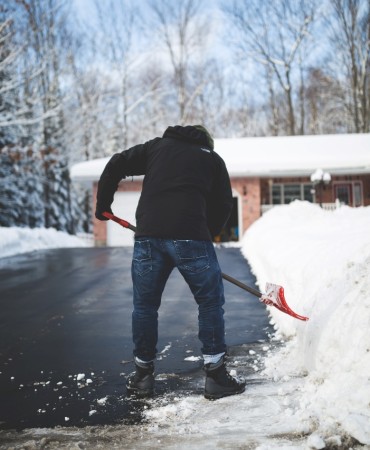When Nashville faces wintry weather, it’s important to be prepared.
Socket and the Department of General Services Division of Sustainability wishes to remind employees and residents about best practices for de-icing (the process of removing snow and/or ice from a surface). Safety is the most important consideration for de-icing and snow clearing efforts, but it is important to remember that de-icing materials impact more than the snow or ice they melt. How and when we use these materials is essential to the health of our waterways, vegetation, and wildlife.
The most effective de-icing agents have chemical formulas containing chloride and acetate. Salt (NaCl) is the most common. But others, such as magnesium chloride (MgCl2) and potassium acetate (CH3CO2K) are common examples too. Unfortunately, these extraordinary “melters” have negative effects on the environment (salts more pronounced than acetates). Some of these negative effects include preventing plants from absorbing moisture, leaching heavy metals, and creating algae blooms. Although researchers continue to pursue a completely safe alternative to those formulas containing chloride and acetate, none yet exists. Brands that advertise eco-friendly products often still contain large proportions of chloride or acetate; or these brands are not effective at temperatures below freezing!
Abrasive substances, such as sand, and organic additives such as cheese brine, pickle juice, and beet sugar (to name a few!), can also assist in making winter travel safer. The effectiveness of abrasives, though, is limited to less-travelled roads and those with slower speeds. And sand can cause air and water quality issues and requires a larger amount of product (as compared with deicers). Organics can be added to salt-based de-icers to reduce the amount of salt needed, but the materials can negatively impact water quality.
And then, there are even more creative solutions. The small city of Holland, Michigan uses an innovative snow melt system to keep its downtown sidewalks and streets snow-free. Waste heat from power generation is used to heat water, which is circulated through 190 miles of tubing laid underneath the pavement and sidewalks, back to the Holland BPW power plant!
So, given that there’s no “silver bullet” for de-icing, what can you do?
Avoid Unnecessary Travel
If you can stay put, do so. Avoiding travel on icy and snow-covered roadways is the best way to minimize your risk and keep the roads clear for snowplows, deicing trucks, and other emergency vehicles.
Wear Proper Shoes
If you do venture out in (ideally an All-Wheel-Drive) vehicle, be sure your tire tread is good, and use chains if available and applicable. If you are on foot, choose boots with a solid toe and bottom tread will help increase your grip on icy surfaces.
Shovel First
Shovel snow early and often; then decide whether to use a de-icing agent. If you must use a de-icer, your shoveling will not have been in vain. De-icers work best on thin layers of precipitation.
Don’t Over-apply
Use just enough. A general rule is 2 lbs. of de-icer for every 500 sq. ft. One pound of de-icer is approximately one heaping 12 oz. coffee mug.
Place Carefully
Apply materials only where needed and keep de-icing materials away from plants and foliage.
Clean up and Reuse
Sweep up left over salt and store it properly for reuse. This saves money and keeps unused product from washing into streams and rivers, where it can negatively impact the aquatic ecosystem.
By being careful in how we store, apply, and clean up deicers, we can maximize their efficacy and minimize the negative environmental impacts! Happy winter, y’all!
Material for this blog was compiled from the Cary Institute of Ecosystem Studies’ 2010 report, Road Salt: Moving Toward the Solution, as well as the Center for Environmental Excellence by AASHTO’s 2013 report, Winter Operations and Salt, Sand, and Chemical Management, and Minnesota Public Radio’s 2019 report “Are there eco-friendly alternatives to road salt?”
Blog Author
This blog was originally written in 2018 by intern Jake Rachels, and was updated in 2022 by Sustainability Division staff.

